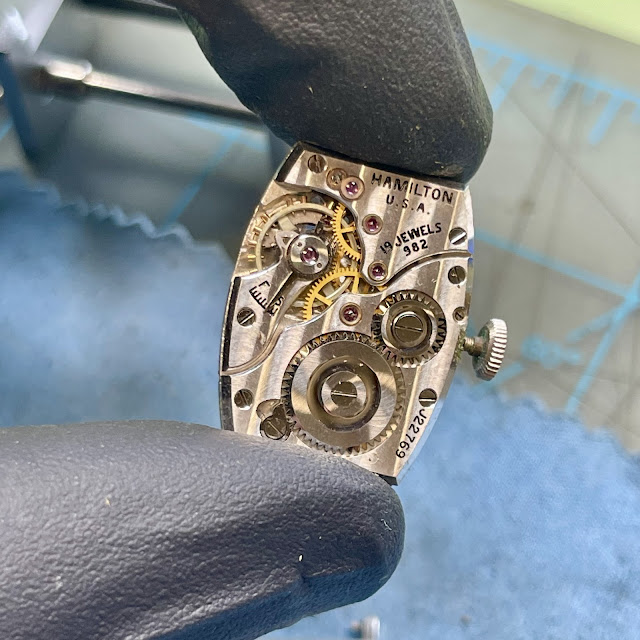Hamilton produced watches in over a dozen different materials. Probably the least common was platinum. Hamilton alloyed platinum with rhodium and later, iridium, which was slightly less expensive. However, platinum doesn't really polish well so I think the alloy with rhodium or iridium was really intended to give the case a little luster and not so much a cost factor.
Platinum was used in a few models but the two most common, and cataloged, were the Rutledge and the Cambridge. The former was introduced in 1935 when the "new" 14/0 sized movements were introduced. The latter replaced the Rutledge when it was discontinued in 1951. That means the Rutledge had quite the run for a Hamilton model - seventeen years, if you include a slight hiatus for WWII.
In 1935 the Rutledge was priced at $175. That's about $4,100 in today's currency - a hardy sum considering it was in the middle of the Great Depression.
The price point remained the same in 1937 when my project watch was produced. It's interesting to see the color of the strap in the catalog... is it gray, brown, or something in between?
The Rutledge was priced at $300 once it returned to the lineup after WWII. Interestingly, $300 in 1947 is slightly less than $4,100 in today's value so you can see the impact of inflation during the war.
My project watch dates to 1937, based on the engraving on the case back. Overall it's in very good condition. Note the model uses female spring bars. Also note the crown is sticking out from the case - that's a little unusual. I should recess into the side so I suspect this may be a replacement crown and slightly too large for the recess.
The hands on my project watch are called "alpha" or "pointex" style. The catalog shows the Rutledge was outfitted with "spear" style hands and my project watch still has a spear second hand. So these hands are replacements. That's okay though, by 1951 the Rutledge was outfitted with alpha hands.
The case back has the initials of it's original owner along with the year. The back has quite a few scratches. Platinum doesn't polish well so I'm going to leave it as is - it's good honest wear for an almost 90 year old watch.
Fortunately the watch came with female spring bars. These are actually hard to find. I'll clean these with the rest of the watch parts.
This dial appears to be original and unmolested. It's a little dirty but I may be able to spruce it up a bit.
The movement inside is a 982 caliber with 19 jewels, just as it should be. Later models would get the 982M but before 1940 the 982 was the top of the line. Based on the serial number, this movement dates to 1937, just as it should.
Notice this movement has a split set bridge and set lever spring. This is a unique feature of the earliest 14.0 movements. By the late 1930s it would be combined into a single part.
The mainspring still contains a blue steel mainspring. I have not doubt that it's "set" and has lost the majority of it's strength.
Yup, no surprise here. The spring is still in a tight coil after it's removed from the barrel. I'l replace it with a fresh white alloy Dynavar spring.
Everything is cleaned and ready to be reassembled. Notice how clean the female spring bars are!
Although frozen in time, the watch is ticking away with a nice motion and sitting on the timer.
The timing is not too bad but the amplitude is a little on the low side. It may come up after it runs for a little while.
I paired the finished project with a nice brown leather strap. I also shortened the stem a little to bring the crown closer to the case. I think it looks much better.
















Well Done. Always loved this model. Cheers
ReplyDelete